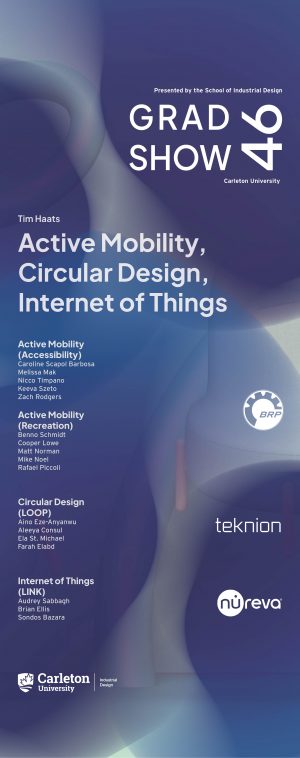Active Mobility
BRP – Active Mobility Solutions for Recreation and Accessibility
Active mobility is the transport of people and/or goods through non-motorized means. It pertains to movement that is either partly or wholly driven by human muscle power. The simplest form of active mobility is walking, but there are many products that provide active mobility assistance such as bicycles, scooters, wheelchairs, rollerblades, snowshoes, etc. This form of transportation provides many benefits to the health of people and the planet, but there are also several challenges relating to things like safety, security, accessibility, and convenience that need to be addressed. In partnership with BRP, students in this group will explore innovative design solutions to promote and enhance active mobility while considering emerging trends and technological advancements that will shape the future of personal transportation.
Circular Design
Teknion – Sustainable Design for a More Circular Economy
Circular design is a way of designing products and services sustainably to meet the needs of the circular economy. A circular economy is a model of production and consumption that aims to eliminate waste and pollution, recirculate products and materials at their highest value, and regenerate nature. It involves sharing, leasing, reusing, repairing, refurbishing, and/or recycling existing materials and products for as long as possible to combat the challenges of the linear economy in which we predominantly live. In partnership with Teknion, students in this group will explore the principles of circular design and apply them to the development of innovative design solutions that help improve an existing product or component, or that propose a new product to address unmet user needs for a specific context of choosing.
The Internet of Things
Nureva – New Design Solutions through Connected Products
The Internet of Things (IoT) is the collection of physical objects with sensors, processing capabilities, software/firmware, and other integrated technologies that exchange data with other devices and systems over the internet or other communication networks. These include products such as smart home appliances, wearable trackers, connected medical devices, safety monitoring equipment, etc. One of the major benefits of IoT-enabled products, systems, and services is that they have the ability to collect and utilize diverse data to provide valuable insights, improve efficiencies, reduce costs, improve safety, etc. In partnership with Nureva, students in this group will explore innovative design solutions that take advantage of this benefit by addressing unmet user needs in a specific context of choosing.
